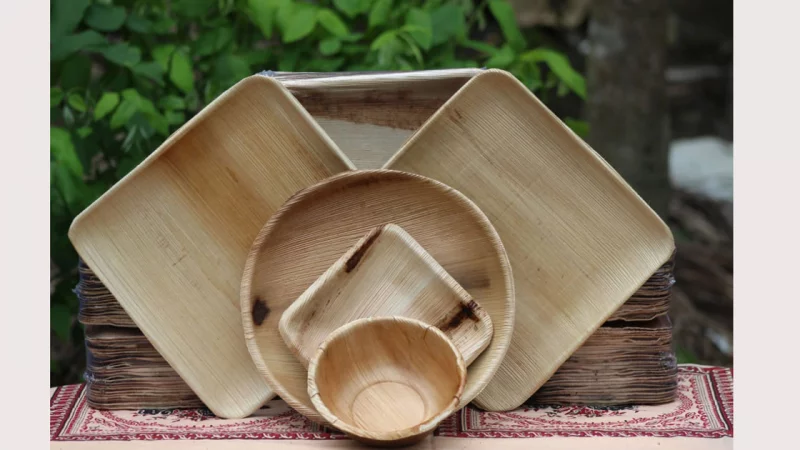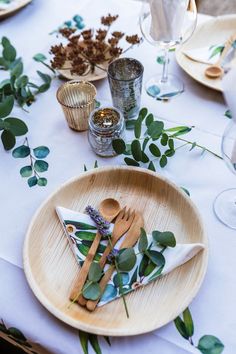Introduction
In today’s world, where sustainability meets style, palm leaf plates stand out as a testament to eco-friendly elegance. These luxurious tableware options not only promise to elevate your dining experience but also offer a nod to environmental responsibility. Let’s delve into the world of palm leaf plates, exploring their benefits, manufacturing process, and why they are the perfect choice for those looking to blend luxury with sustainability.
Table of Contents
The Rise of Eco-Friendly Tableware
Why Eco-Friendly Tableware?
The shift towards eco-friendly tableware stems from a growing awareness of the environmental impact of single-use plastics and non-biodegradable materials. Traditional disposable tableware, such as plastic plates, cutlery, and cups, contribute significantly to global pollution, particularly in oceans and landfills. The production and disposal of plastic tableware release harmful chemicals and take hundreds of years to decompose, posing a threat to wildlife and ecosystems.
In contrast, eco-friendly tableware, made from materials like bamboo, palm leaves, and biodegradable plastics, offers a sustainable alternative. These materials decompose much faster than their plastic counterparts and are often produced in a more environmentally friendly manner. By choosing eco-friendly tableware, consumers can enjoy the convenience of disposable items without the environmental guilt.
The Benefits of Eco-Friendly Tableware
- Reduced Environmental Impact: Eco-friendly tableware is biodegradable and compostable, meaning it breaks down much faster than plastic, reducing landfill waste and pollution.
- Sustainable Resources: Many eco-friendly tableware items are made from renewable resources, such as bamboo or fallen palm leaves, which do not require the cutting down of trees or extensive water usage.
- Non-Toxic: Unlike some plastics, which can leach harmful chemicals into food and drinks, eco-friendly tableware is often made from natural materials that are safer for both people and the planet.
- Energy Efficiency: The production of eco-friendly tableware typically requires less energy compared to plastic tableware, contributing to lower carbon emissions.
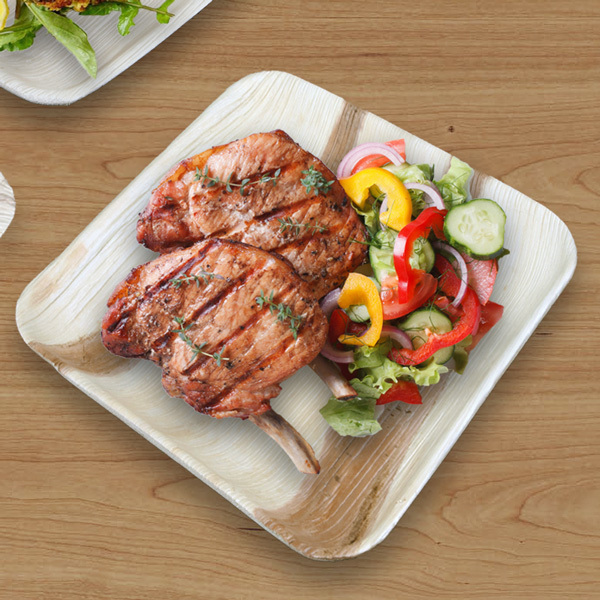
The Growing Popularity of Eco-Friendly Tableware
The rise of eco-friendly tableware is evident in both consumer behavior and business practices. More people are opting for sustainable options for their personal use, events, and even in their businesses. Restaurants, cafes, and catering services are increasingly adopting eco-friendly tableware to meet customer expectations and comply with environmental regulations.
Moreover, the aesthetic appeal of eco-friendly tableware, with its natural and rustic look, has made it a popular choice for weddings, parties, and other events seeking a unique and environmentally friendly vibe. The market for eco-friendly tableware is expanding, with a wide range of products now available, from elegant bamboo plates to sturdy palm leaf bowls and compostable cutlery.
Crafting Process of Palm Leaf Plates
1. Collection of Palm Leaves
The process begins with the collection of fallen leaves, primarily from the Areca palm tree. These leaves are considered agricultural waste and are gathered without harming any trees, ensuring a sustainable and environmentally friendly start. This method of sourcing materials directly contributes to waste reduction and promotes a circular economy.
2. Cleaning
Once collected, the leaves undergo a thorough cleaning process. They are washed with water to remove any dirt and debris. This step is crucial for ensuring the final product is hygienic and safe for use. The cleaning process is generally done without the use of harmful chemicals, maintaining the natural integrity of the leaves.
3. Drying
After cleaning, the leaves are left to air dry. This natural drying process is important for removing moisture, which prepares the leaves for the next stage of production. The use of sunlight for drying further reduces the carbon footprint of the manufacturing process, aligning with the eco-friendly ethos of palm leaf plate production.
4. Shaping and Pressing
The dry leaves are then cut into the desired shapes and sizes, depending on the type of tableware being produced. This is followed by the heat-pressing process, where the leaves are placed between two heated molds. The heat and pressure applied during this stage sterilize the leaves and mold them into sturdy plates, bowls, or other forms of tableware. This process is completely natural and does not involve any synthetic additives or chemicals, preserving the biodegradability of the products.
5. Trimming and Finishing
After pressing, the edges of the plates are trimmed to ensure a smooth finish. This step also helps in achieving uniformity in shape and size. The final product is then subjected to a quality check to ensure that it meets the required standards. Plates that pass this inspection are ready to be packaged and distributed.
6. Packaging
The finished plates are packaged in eco-friendly materials, maintaining the sustainable approach of the entire process. The packaging is designed to protect the plates during transportation while minimizing waste.
Design and Aesthetics
Natural Beauty and Uniqueness
One of the most striking features of palm leaf plates is their inherent natural beauty. Unlike mass-produced, synthetic tableware, each palm leaf plate boasts a unique pattern, texture, and coloration, reflecting the individual leaf from which it was made. This variability ensures that no two plates are exactly alike, offering a bespoke dining experience that celebrates the imperfections and diversity of nature.
The warm, earthy tones of the plates—ranging from light beige to rich browns—complement a variety of dining settings, from rustic outdoor picnics to elegant dinner parties. The natural grain and texture visible on each plate add a tactile dimension that enhances the sensory experience of dining, making every meal feel special and connected to the earth.
Sustainability as Design Philosophy
The aesthetic appeal of palm leaf plates is deeply intertwined with their sustainability. The eco-friendly nature of these plates is not just a functional attribute but a core aspect of their design philosophy. Consumers are increasingly seeking products that reflect their personal values, and the visible natural and sustainable qualities of palm leaf plates make a statement about environmental responsibility and conscious living.
This integration of design and sustainability resonates with contemporary trends towards minimalism and authenticity in home decor and dining. Palm leaf plates embody this ethos, offering a stylish yet understated option that aligns with the growing preference for products that are not only beautiful but also beneficial to the planet.
Versatility in Event Styling
Palm leaf plates are remarkably versatile in terms of event styling. Their natural elegance makes them suitable for a wide range of occasions, from casual gatherings to formal events. They can seamlessly blend with various themes, whether you’re aiming for a bohemian vibe, a minimalist aesthetic, or a sophisticated, eco-luxe look.
For event planners and hosts, palm leaf plates offer the opportunity to make a sustainable choice without compromising on style. They can be paired with linen tablecloths, rustic centerpieces, or elegant silverware to create a visually stunning and eco-friendly tablescape. The unique texture and pattern of the plates serve as a conversation starter, highlighting the host’s commitment to sustainability and attention to detail.
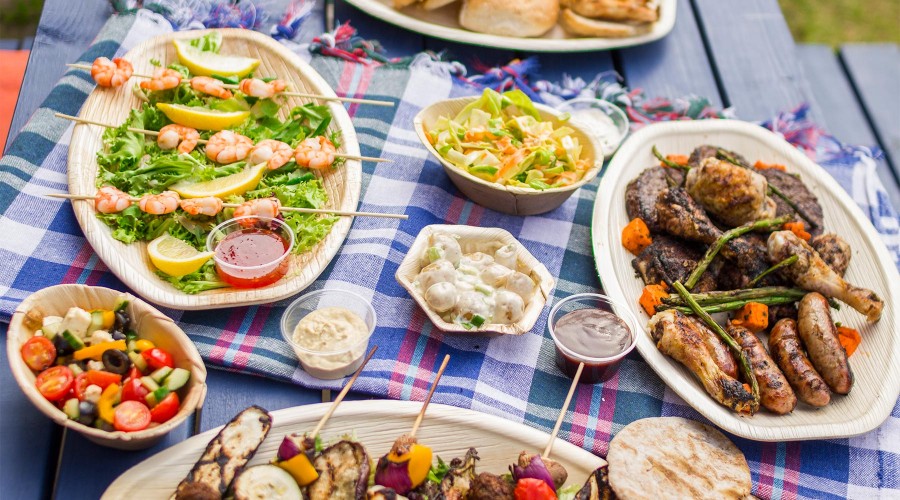
Versatility in Use
Adapting to Various Dining Occasions
Palm leaf plates are uniquely suited for a range of events, from outdoor barbecues and picnics to elegant weddings and corporate gatherings. Their natural appearance and sturdy construction make them ideal for serving all types of food, including hot, cold, wet, or dry dishes. This adaptability allows hosts to serve a diverse menu without worrying about the plates bending, breaking, or soaking through, a common issue with other disposable tableware options.
Casual to Formal Settings
The rustic charm of palm leaf plates lends itself well to informal, outdoor settings where the connection to nature is emphasized. They blend seamlessly into garden parties, beach picnics, and backyard barbecues, enhancing the laid-back, eco-friendly vibe of these gatherings. On the other hand, their elegant and unique appearance can elevate the ambiance of more formal events, such as weddings, anniversaries, and gala dinners. By choosing palm leaf plates, event organizers can effortlessly bridge the gap between casual comfort and formal sophistication.
Compostability and Disposal
A significant aspect of the versatility of palm leaf plates is their compostability. After use, these plates can be composted, turning into nutrient-rich soil within a few months. This ease of disposal not only makes them an environmentally friendly option but also simplifies the cleanup process after events, particularly large ones. For events that prioritize sustainability, the ability to compost tableware adds to the overall green credentials and reduces the environmental impact of the occasion.
Cultural and Thematic Events
Palm leaf plates are also an excellent choice for cultural and thematic events, where the authenticity and aesthetic of the tableware can enhance the overall experience. They can complement a tropical or jungle-themed party, a rustic country wedding, or a traditional cultural feast, adding an authentic touch to the themed decor. Their natural elegance and connection to traditional craftsmanship can help create a more immersive and meaningful dining experience for guests.
Educational and Awareness Events
For events focused on environmental education and sustainability awareness, palm leaf plates serve as a practical example of eco-friendly practices. They can be used as a conversation starter about sustainability, waste reduction, and the importance of choosing renewable resources. By incorporating palm leaf plates into such events, organizers can demonstrate a commitment to environmental stewardship and inspire participants to consider sustainable choices in their daily lives.
Comparing Palm Leaf to Other Eco-Friendly Options
Palm Leaf vs. Bamboo Plates
Palm Leaf Plates:
- Made from fallen leaves of the Areca palm, requiring no tree cutting.
- Each plate has a unique texture and pattern, adding to its aesthetic appeal.
- Completely biodegradable and compostable within a few months.
Bamboo Plates:
- Crafted from bamboo, a highly renewable resource due to its fast growth rate.
- Generally uniform in appearance, offering a consistent look but less uniqueness than palm leaf plates.
- Biodegradable, but the rate of decomposition can vary based on the thickness and treatment of the bamboo.
Comparison: Palm leaf plates excel in providing a unique, natural aesthetic with each plate being distinct. Bamboo plates, while also eco-friendly and sustainable, offer a more uniform look and feel. Both materials are biodegradable, but palm leaf plates may compost more readily due to their thinner and less processed structure.
Palm Leaf vs. Recycled Paper Plates
Palm Leaf Plates:
- Strong and sturdy, capable of handling heavy or liquid foods without bending or soaking through.
- Naturally biodegradable and compostable, leaving no trace in the environment after disposal.
Recycled Paper Plates:
- Made from recycled paper, contributing to waste reduction and the conservation of resources.
- Often coated with a thin layer of plastic or wax to improve durability, which can complicate recycling and composting processes.
Comparison: While recycled paper plates support the recycling industry and can be a more sustainable option than virgin paper plates, the presence of coatings can hinder their environmental benefits. Palm leaf plates, in contrast, maintain their compostability and environmental integrity without the need for such coatings, offering a more natural and eco-friendly option.
Palm Leaf vs. Compostable Plasticware
Palm Leaf Plates:
- Offer a completely natural and plastic-free dining experience, reducing reliance on fossil fuels.
- Biodegrade in a home compost setting, making them accessible for eco-conscious consumers without industrial composting facilities.
Compostable Plasticware:
- Made from plant-based materials such as cornstarch, appearing and feeling similar to traditional plastic.
- Requires industrial composting facilities to break down effectively, which may not be available in all areas.
Comparison: Compostable plasticware provides an alternative to traditional plastics, reducing some environmental impacts, but its dependence on industrial composting limits its accessibility and effectiveness as an eco-friendly option. Palm leaf plates, being naturally compostable even in home settings, offer a more universally sustainable solution.

How to Choose the Right Palm Leaf Plates
1. Event Type and Theme
The nature of your event should guide your choice of palm leaf plates. Consider whether the event is casual or formal, and think about the overall theme. For rustic or outdoor weddings, larger, more natural-looking plates can add to the aesthetic. For formal dinners, look for plates with a more refined finish. The unique patterns of palm leaf plates can complement a variety of themes, from tropical to eco-chic.
2. Size and Shape
Palm leaf plates come in a range of sizes and shapes, including round, square, and rectangular options. The size and shape you choose should depend on the type of food you plan to serve. Larger plates are suitable for main courses, while smaller plates are ideal for appetizers or desserts. Consider also if you prefer a traditional round plate or if a square or oval plate might better suit your table setting and presentation style.
3. Durability and Functionality
While all palm leaf plates are known for their durability, the thickness and edge design can vary. If you’re serving heavier or more liquid-based dishes, look for plates with a deeper basin or higher edges to prevent spills. For lighter fare, a standard plate may suffice. Always check the manufacturer’s information regarding the plate’s ability to hold up against hot and wet foods.
4. Compostability and Environmental Impact
Although all palm leaf plates are biodegradable and compostable, you may want to consider the specific environmental impact of the plates you choose. Look for products that are certified compostable and have been produced using sustainable practices, including ethical labor practices and minimal water usage. This ensures that your choice is supporting broader environmental and social sustainability goals.
5. Quantity and Packaging
Determine the quantity of plates you’ll need based on your guest list, and consider whether the plates come in a package size that suits your needs. Also, assess the packaging materials for sustainability. Ideally, the plates should be packaged in eco-friendly materials that reflect the sustainable nature of the product itself.
6. Reviews and Recommendations
Before making a purchase, read reviews from other customers to gauge the quality and performance of the palm leaf plates. Recommendations from friends or event planners who have used palm leaf plates can also provide valuable insights into the best products on the market.
7. Price
While palm leaf plates can be more expensive than traditional disposable tableware, their environmental benefits and unique aesthetic justify the cost for many consumers. However, prices can vary widely between brands and retailers, so compare options to find plates that fit your budget without compromising on quality or sustainability.
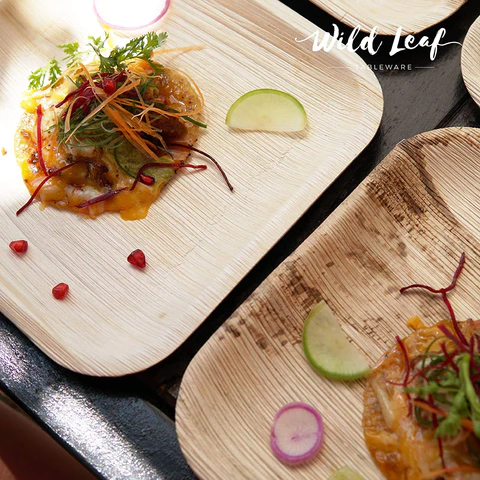
Conclusion
Palm leaf plates offer an eco-friendly yet luxurious option for those seeking to make a statement with their tableware. Their natural beauty, durability, and compostability make them an ideal choice for any occasion, embodying the essence of eco-friendly elegance.
FAQs
- Are palm leaf plates safe for hot food? Yes, they are designed to handle hot, cold, and even liquid foods without compromising their structure or safety.
- How long do palm leaf plates take to compost? They typically compost within 2-6 months in a proper composting facility or compost pile.
- Can palm leaf plates be reused? While they are intended for single use, they can be gently cleaned and reused for dry or cold items if they haven’t been heavily soiled.
- How are palm leaf plates different from other disposable plates? Palm leaf plates are unique in their natural composition, biodegradability, and the elegant aesthetic they bring to the table, unlike plastic or paper options.
- Where can I purchase palm leaf plates? They are widely available online and in stores specializing in eco-friendly products.

